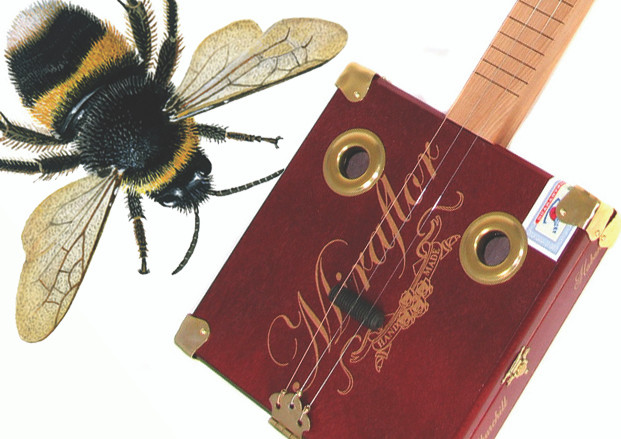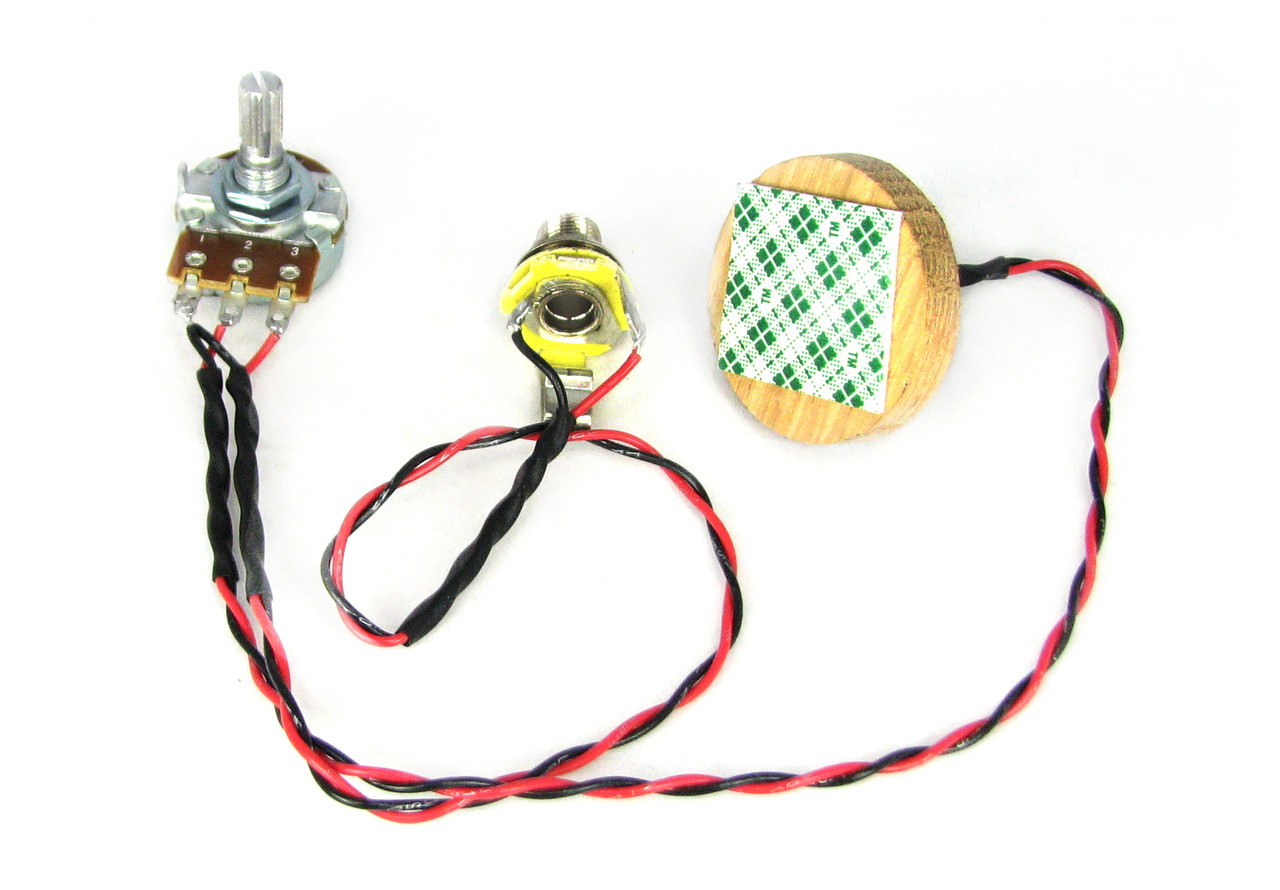Hum and Buzz - Some Tips for Effective Electrification
Electrifying your cigar box guitar or other homemade instrument build can be a very rewarding experience. Being able to plug into an amp not only gives you more volume, but it opens the door to a huge range of effects that would not otherwise be available. And it is a proven fact that having a pickup in a guitar makes it easier to sell - being able to plug in and rock out evokes images of Eddie Van Halen and Slash and is sure to get any would-be rocker's blood pumping.
In an ideal situation, electrifying your build is as simple as gluing in a piezo (or mounting in a magnetic pickup), wiring it to a jack, and bingo. You finish the build, plug it into an amp and it sounds great. Sometimes, that is exactly what happens. Those are the good times.
Unfortunately, sometimes it's not so good. You finish your build, plug it into your amp, and... mmmmmmmmmmmmm. The dreaded 60-cycle hum. But wait, you say... the last build I did was just like this, and it didn't hum! Or you think, this harness I bought from C. B. Gitty must be no good! That shyster! Fortunately there are some things you can do to minimize (and hopefully eliminate) hum and buzz in your guitar.
The exact causes of hum and buzz in electric guitar pickup circuits can be a very arcane and involved subject. I don't claim to know everything about it, and there are plenty of other builders out there who may disagree with what I'm about to say, or who would offer their own tips. That's fine, more power to them. My goal is just to give some pointers to people who want to know what to do. We have built hundreds of electrified CBGs in the C. B. Gitty workshop, and these are some of the methods that have worked for us.
- Pre-test your equipment. Whenever possible, get in the habit of testing your harness before it is installed in the box. For piezo harnesses, you can plug it into your amp and tap on the piezo or hold it against another instrument's sound board with your fingers. Give the instrument a strum and you should hear sound through your amp. If the harness has a volume pot, test its full range. Strangely, sometimes a pickup harness will have no hum when it is not installed, but will once installed.
- Test your pickup circuit before finishing the instrument/sealing the box. Most of the tips and tricks below are a lot easier if the guitar hasn't been sealed up. Get in the habit of testing your electronics before finishing the instrument. Even if it isn't strung up yet, you should be able to tap over where the piezo is installed and hear sound through the amp. For magnetic pickups it's a little trickier if the instrument isn't strung up yet, but with a little dexterity and another guitar, you can have your new build plugged in to the amp, then quickly strum the second guitar and hold its strings over the pickup in your new build, and you should hear sound through the amp.
- Avoid creating wire coils. Any time a conductor (like the wire leads in your pickup circuit) is coiled, wacky things can happen. It can act like an antenna making the circuit more susceptible to outside interference from electric motors, fluorescent lights, etc. While it is tempting to wrap any excess wire lengths inside the instrument up into tight little coils, fight the urge and find other ways to deal with the problem.
- Pots are hum-prone. Adding a volume pot to a pickup circuit is a common cause of hum and buzz. Make sure that you ground to the back of the pot's metal casing.
- Look around. Are there fluorescent lights right overhead? Anything else that might be producing electromagnetic noise? If so, try moving to a less electrically busy place and trying again. You might find the hum is reduced.
- Check your power source. To build on #5, your amp and its power source might be the cause of the buzz. AC (wall) power is inherently noisy and its 60 hertz frequency (in the US, 50 hertz elsewhere) can come through your amp as the "60-cycle hum". If there are fluorescent lights or electric motors plugged into the same circuit as your amp, their electromagnetic noise can manifest itself through the speaker. Try plugging into different circuits in your house or workshop, and see if the noise reduces.
- Ground to the strings. If touching the metal shaft part of your output jack with your finger greatly reduces the amount of hum you are getting, then you definitely have a grounding problem. One common way to address this is to run a wire from the ground leg of your pickup circuit in such a way that it connects to your strings. This is a lot easier to do if you have a metal tailpiece... just run a discrete wire to the tailpiece, and once it's strung up you should find that the hum is greatly reduced. If you don't have a metal tailpiece but do have a metal saddle, you can run a lead to that. If you don't have either of these, you'll have to get creative in finding a way to add your strings to the ground circuit - it really can help.
- Move stuff around. If none of the above things help, if possible you should consider moving the components in your build around. As I said above, the whole topic of hum and buzz can be pretty arcane topic. Sometimes the same harness will hum in one build and not in another. Why? Heck if I know. But moving things around can sometimes help.
- Bad components? Possibly. It is always possible that bad components are to blame. At C. B. Gitty we pre-test every harness we make before it ships out, and we don't ship out any that have hum problems. But if you bought from somewhere else or made your own harness, it's always possible that a wiring fault (look for a single hair of wire going from hot to ground!) bad solder joint or bad component is to blame. Check your connections carefully and try swapping things out to see if you can isolate the cause.
- Replace it and try it in another build. If nothing else works, all you can really do is give up and try another harness. Save the hummer for another build if you're an optimist.
I hope that these tips will help our customers work through issues of hum and buzz in their builds. If you have other tips that have worked for you, let us know and we'll add to the list! Happy hum-free building!
Recent Posts
-
2024 World's Wildest Electric Cigar Box Guitar Build-Off Winners!!!
C. B. Gitty Crafter Supply is proud to announce the winners of the 2024 "World's Wildest Electric Ci …31st Oct 2024 -
Improved C. B. Gitty: Easier Than Ever! (Work in Progress)
Ben “Gitty” has been cleaning house, making our website even easier find your favorite parts, kits a …7th Oct 2024 -
Build-Off Contest 2024: The World's Wildest ELECTRIC Cigar Box Guitar
CBGitty.com is looking for the WILDEST, LOUDEST & MOST DIABOLICAL electric cigar box guitar ever …6th Sep 2024





